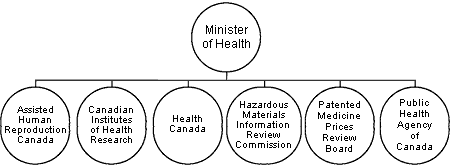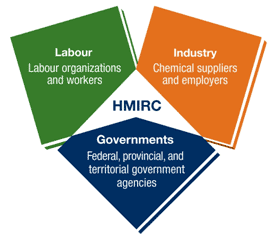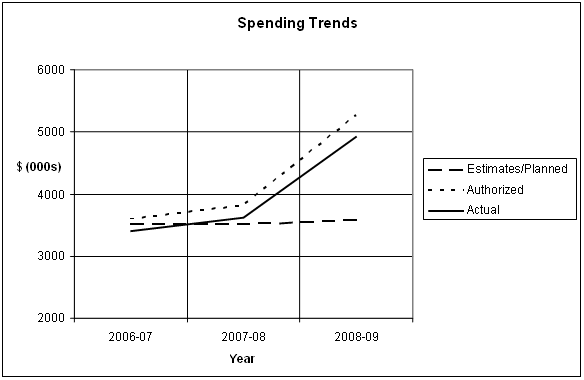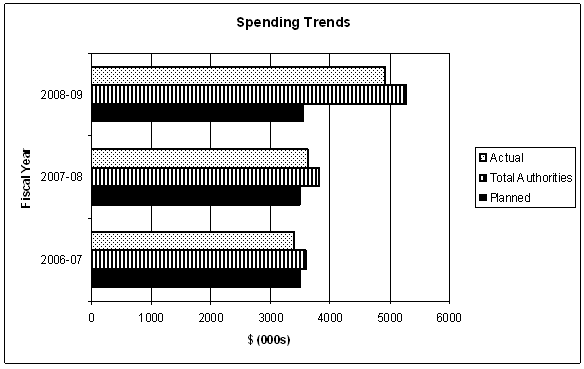Common menu bar links
Breadcrumb Trail
ARCHIVED - Hazardous Materials Information Review Commission
 This page has been archived.
This page has been archived.
Archived Content
Information identified as archived on the Web is for reference, research or recordkeeping purposes. It has not been altered or updated after the date of archiving. Web pages that are archived on the Web are not subject to the Government of Canada Web Standards. As per the Communications Policy of the Government of Canada, you can request alternate formats on the "Contact Us" page.
Section I Overview
President's Message
I am pleased to submit the Departmental Performance Report 2008-2009 for the Hazardous Materials Information Review Commission (HMIRC). This report reaffirms the Commission's commitment to both Canadian worker health and safety and Canadian chemical industry competitiveness through a high standard of service delivery and innovation.
The four priorities set by HMIRC for 2008-2009 were improved client service, modernized legislation, international harmonization and management excellence. These priorities were intended primarily to address the streamlining of operations in order to increase service capacity and efficiency, but also to support the implementation of international standards for hazard communication and to strengthen administrative functions within the Commission.
During the year the Commission successfully implemented a Backlog Elimination Plan and met the target of 500 claims processed for the first year. This plan was initiated with a presentation of HMIRC's 2008-2009 Program Integrity Business Case to Treasury Board Secretariat. Once the funding agreement with Health Canada was finalized, HMIRC was able to implement strategies to recruit new scientific staff, to introduce a shorter, more intensive orientation/training program, and to develop specialized and coordinated tools to assist claim processing, including an integrated data management system. These activities address not only the claims backlog, but will also contribute to sustainable workload management in the future.
Various legislative activities in 2008-2009 had great significance for HMIRC. One of the highlights was the coming into force of a revised Hazardous Materials Information Review Act and Regulations in October 2008. This was the culmination of many years of analysis and consultation with stakeholders through the Commission's tripartite governing body, the Council of Governors. These amendments have now been operationalized, resulting in a more efficient and collaborative claim process which benefits both workers and industry and contributes directly to the achievement of the Commission's strategic outcome.
In the coming years the evolution of the Hazardous Products Act and related regulations, due to both domestic and international elements, will affect the work of the Commission. This legislation contains federal supplier obligations under the Workplace Hazardous Materials Information System (WHMIS) and requires companies that wish to protect their trade secrets to submit claims for exemption to the Commission. The Commission has closely followed the developments of the Globally Harmonized System for the Classification and Labelling of Chemicals (GHS) because of the impact these standards will have on its work. While the protection of confidential business information will remain unchanged, the preparation of hazard communication products, such as the Material Safety Data Sheets (MSDS), will certainly be affected. Canada has already committed to GHS implementation; it will be up to the Commission to redefine its processes when the time comes. HMIRC will be working proactively and collaboratively with Health Canada and other partners to ensure enhanced competition and improved worker health and safety.
The Commission was pleased by Treasury Board's acknowledgement of its organizational excellence; following the 2008-2009 Round V Management Accountability Framework review, HMIRC received strong ratings in the categories of corporate performance and workforce development. Additional resources for corporate services have significantly strengthened the Commission's planning and reporting capacity. Internal controls in financial systems have been enhanced and key positions filled by staff bringing much needed expertise to these areas. This has allowed HMIRC to coordinate its management activities in a strategic, results-based direction.
I am proud of the accomplishments and the hard work of HMIRC staff. The Council of Governors' support and guidance continue to make a tangible contribution to the organization's effectiveness. I am convinced this collaborative partnership has well-positioned the Commission for continued success.
Sharon A. Watts
President and CEO
Summary Information
Health Portfolio Overview
The Minister of Health, through the work of the Health Portfolio, is responsible for maintaining and improving the health of Canadians. In addition to the Hazardous Materials Information Review Commission (HMIRC), the Portfolio consists of Health Canada, the Public Health Agency of Canada, the Canadian Institutes of Health Research, the Patented Medicine Prices Review Board and Assisted Human Reproduction Canada. Each member of the Portfolio prepares its own Departmental Performance Report.

The Health Portfolio consists of 12,158 full-time equivalent employees, with an annual budget of 4.7 billion.
Raison d'�tre
HMIRC is an independent, quasi-judicial organization which provides a mechanism to protect the trade secrets of companies that manufacture, supply and/or use hazardous materials, and to accurately inform Canadian workers who handle such materials about the intrinsic health and safety hazards.
Mandate
The Hazardous Materials Information Review Act mandates the Commission to:
- Register claims for trade secret exemptions and issue registry numbers.
- Adjudicate and issue decisions on the validity of claims for exemption on the basis of prescribed regulatory criteria.
- Make decisions on the compliance of MSDSs and labels with WHMIS requirements.
- Convene independent boards with representatives of labour, suppliers or employers to hear appeals from claimants or affected parties on decisions, undertakings and orders.
Mission
The Commission's mission is to:
- Ensure a balance between industry's right to protect confidential business information and the right of workers to know about the hazardous materials they deal with in the workplace;
- Provide a trade secret mechanism within WHMIS; and
- Resolve complaints and disputes impartially, fairly and promptly through statutory or alternate means.
Vision
The Commission's vision is to:
- Make decisions based on both sound scientific principles and regulations, and take pride in being a professional quasi-judicial organization seeking creative and progressive approaches to enhancing workplace safety; and
- Resolve complaints and disputes, whether under statutory mandate or not, in a manner that is impartial, fair and prompt.
Cooperative partnerships

HMIRC works collaboratively and cooperatively with a broad range of WHMIS stakeholders:
- federal, provincial and territorial government agencies
- labour organizations and workers
- chemical suppliers and employers
As an independent agency, the Commission is a model of industry, labour and government consultation, consensus and cooperation. The Commission makes a tangible contribution to worker health and safety and is a strategic partner to both the industry and employers. Through its work, the Commission supports the Government of Canada's priority of "healthy Canadians" by ensuring that workers in Canada have complete and accurate information to take the appropriate actions to minimize the health risks they encounter in their workplace. HMIRC's work also supports the federal, provincial and territorial governments in delivering their occupational safety and health regulatory activities, making the Commission one of very few adjudicative bodies in Canada that represent multiple levels of government.
Responsibilities
The Commission enables chemical companies to protect their trade secrets and, at the same time, ensures that accurate health and safety information about hazardous chemicals is available to workers in order to reduce workplace-related illness and injury. The Commission's activities are key components of WHMIS, which was created in the late 1980s through a consensus of labour, industry and government. The success of WHMIS depends on cooperation among all these partners. All three groups play an integral part in ensuring that the information workers need to know about hazardous chemical products is available.
WHMIS requires that manufacturers and suppliers provide employers with information on the hazards of materials produced, sold, or used in Canadian workplaces. The employers, in turn, provide that information to employees through product labels, worker education programs, and MSDSs. A product's MSDS must fully disclose all hazardous ingredients in the product, its toxicological properties, any safety precautions workers need to take when using the product, and treatment required in the case of exposure.
When a supplier introduces a new or improved product and wants to protect the identity of one or more of the ingredients or the concentration, the company applies to HMIRC for an exemption from the requirement to list all hazardous ingredients on the product's MSDS. Once the application is complete, HMIRC registers the claim and the product can be made available in the marketplace. The Commission then issues a decision on the validity of the claim and, to protect worker safety, verifies the compliance of the MSDS and, in some cases, the label with the Hazardous Products Act and Controlled Products Regulations, and with provincial and territorial occupational health and safety acts. The Commission offers voluntary compliance undertakings which, if not accepted, lead to the issuance of orders for any changes that are necessary to the MSDS or product labels.
The Hazardous Materials Information Review Act and associated regulations, as applied by HMIRC, provide a mechanism to protect the rights of business and workers. When required, the Commission convenes independent boards to hear appeals from claimants or affected parties challenging decisions and orders.
In addition, HMIRC responds to requests from federal, provincial or territorial government health and safety officials for information about claims for exemption to help these officials administer and enforce their WHMIS obligations.
Strategic Outcome and Program Activity Architecture (PAA)
Portfolio Department:
Health Canada
Agency:
Hazardous Materials Information Review Commission (HMIRC)
Strategic Outcome:
Trade secret exemptions are provided in a way that balances the right of industry to protect their confidential business
information with the right of workers to receive accurate information concerning the health and safety hazards posed by
chemicals in the workplace.
Program Activity: Claims Exemption Process
Under this activity the Hazardous Materials Information Review Commission registers claims for exemption received from a
supplier or employer who wishes to withhold confidential business information, decides on the validity of the claim, adjudicates
and issues decisions on the compliance of the material safety data sheet (MSDS) or label to which the claim relates, and
administers an appeal process to these decisions.
Summary of Performance
| Planned Spending | Total Authorities | Actual Spending |
|---|---|---|
| 3,565 | 5,2751 | 4,921 |
1 Variance due to transfer of $1.7 M from Health Canada through Supplementary Estimates A to HMIRC to address its backlog.
| Planned | Actual | Difference [TB2] |
|---|---|---|
| 35 | 52 | 172 |
2 Variance due to additional staffing as a result of supplementary funding to address the backlog.
| Performance Indicators | Targets | 2008-2009 Performance |
|---|---|---|
| Number of appeals as a percentage of total claims processed | Zero | One appeal received (representing less than 1 % of total claims processed) |
| Program Activity | 2007–2008 | Alignment to Government of Canada Outcomes | ||||
|---|---|---|---|---|---|---|
| 2008-2009 Actual Spending | Main Estimates |
Planned Spending |
Total Authorities |
Actual Spending | ||
| Claims Exemption Process | 3,621 | 3,565 | 3,565 | 5,275 | 4,921 | Healthy Canadians |
| Total | 3,621 | 3,565 | 3,565 | 5,2753 | 4,921 | |
3 Variance between Planned Spending and Total Authorities is supplementary funding to address the backlog.
Contribution of Priorities to Strategic Outcome
The 2008-2009 Report on Plans and Priorities identified the following priorities for the Hazardous Materials Information Review Commission (HMIRC):
- Priority 1 - Efficient client service delivery
- Priority 2 - Modernized legislation
- Priority 3 - International Harmonization
- Priority 4 - Management Excellence
Hazardous Materials Information Review Commission's priorities contributed to the strategic outcome by initiating efficiencies in the claim process and the provision of accurate worker safety information; participating in the review and revision of relevant legislation and planning for the implementation of the international chemical safety standard; enhancing corporate services and program management.
| Program Activity: Claims Exemption Process | |
|---|---|
Expected Results:
|
|
| Operational priorities: Priorities 1,2,3 | 2008-2009 Performance (Ongoing) Status: Met All |
Efficient client service delivery |
The 2008-2009 backlog reduction target was achieved. Additional scientific staff was recruited and trained using a shorter, intensive orientation program and more formalized one-on-one coaching. New operational tools were developed and implemented which produced outputs such as Advice Documents faster. An integrated database was developed to provide evaluators with instant access to various sources of information required for the assessment of claims. |
Modernized legislation |
Amended HMIRC legislation came into force which streamlines the claim process and increases
claimant engagement before a decision is rendered. Enhanced operational processes based on new legislation were
designed and introduced in a manner providing a smooth transition for claimants. |
International harmonization |
The Commission collaborated with Health Canada and other federal departments and provincial/territorial
governments to plan for GHS implementation. |
| Management priorities: Priority 4 | 2008-2009 Performance (Ongoing) Status: Met All |
Management excellence |
A comprehensive business case for funding to support a three-year backlog elimination
and sustainability plan was endorsed and implemented. |
Risk Analysis
Operational Context
Labour, industry and government agree on the importance of preventing illnesses and injuries from hazardous materials in Canadian workplaces. In order to help achieve this goal the Workplace Hazardous Materials Information System (WHMIS), a combination of laws, regulations and procedures, was created in 1987. WHMIS requires suppliers, including manufacturers, importers and distributors, and employers to provide health and safety information about the chemicals produced or used in Canadian workplaces.
As part of the WHMIS initiative, the Hazardous Material Information Review Act and its regulations also came into force. This legislation established the Hazardous Materials Information Review Commission (HMIRC), an independent agency with a quasi-judicial role. The Commission provides the mechanism in Canada which balances the benefit to workers in receiving accurate and complete health and safety information with the benefit to chemical suppliers and employers in protecting confidential business information to foster competitiveness.
Risks and Opportunities
Quality service delivery is essential to the Commission's mandate in order to maintain the confidence of all stakeholders and to fulfill its strategic outcome. As previously reported, a backlog of claims to process has put service delivery at risk. Beginning in 2008-2009, however, a three year Backlog Elimination Plan has been in place and funding secured. The Plan has successfully met its target of 500 total claims processed for this year. All elements of the related strategy have been realized - the introduction of several tools to improve the efficiency of the claim process, the development of an integrated data management system, and an active scientific staff recruitment combined with a shorter, more intensive orientation/training program. These enhancements will contribute to worker safety and the competitiveness of industry in Canada.
Since the introduction of amended HMIRC legislation in the second half of 2008-2009, indications have been very positive regarding its affect on operations. These amendments took effect in October 2008. The intent of these changes was to streamline the claim and appeal process and to speed up the provision of accurate and complete worker health and safety information. Through the Council of Governors, labour, industry, employers and federal/provinicial/territorial government representatives were united in their support for these legislative amendments.
Another piece of legislation, the Hazardous Products Act (HPA), is evolving and the impact on WHMIS components, including the Commission, is uncertain. HMIRC is closely monitoring these developments in partnership with Health Canada.
The issues surrounding the implementation of a new international hazard communication standard, the Global Harmonization System (GHS), is still being studied by committees within Health Canada and other departments. HMIRC has representatives on these committees and is closely following the situation. Although Canada is committed to implementation, the date has yet to be determined. The GHS is certain to cause changes in HMIRC operations, notably in the work on the MSDSs, but the amount of change is still unknown.
The strain to meet central agency reporting requirements has been diminished through successful recruitment of support staff and additional permanent funding to Corporate Services. The additional resources should contribute to an overall improvement in the long term in integrated and collaborative planning activities, accountability, and program management. Areas identified in the Commission's MAF 2008-2009 assessment, including internal audit and evaluation, should be addressed before the next triennial round. These specialized functions, however, will continue to pose a challenge for small agencies which are necessarily staffed with generalists because there is not enough work or resources to support fulltime FTEs in these areas.
The Commission continues to experience problems in the recruitment and retention of staff in spite of an aggressive human resources strategy. This is due mainly to the limited opportunities for permanent employment and advancement within a small agency context. Despite this situation, HMIRC will continue to focus on maintaining its workforce capacity.
Expenditure Profile


Voted and Statutory Items
| Vote # or Statutory Item (S) | Truncated Vote or Statutory Wording | 2006-2007 Actual Spending |
2008-2009 Actual Spending |
2008-2009 Main Estimates |
2008-2009 Actual Spending |
|---|---|---|---|---|---|
30 |
Operating expenditures |
3,025 |
3,231 |
3,097 |
4,452 |
(S) |
Contributions to employee benefit plans |
376 |
390 |
468 |
469 |
|
Total |
3,401 |
3,621 |
3,565 |
4,921 4 |
4 The difference between Main Estimates and Actual Spending is supplementary funding to address the backlog.
In 2008-2009, HMIRC developed a plan to eliminate its backlog of claims for exemption over a three year period (2008-2011) and to prevent it from recurring. However, due to its very small A-Base, which in fiscal year 2008-2009 totaled $3.5 M, the Commission sought supplementary funding for each of the three years, as well as ongoing funding, for 2011-2012 and beyond, to implement the plan.
In January 2008, Health Canada (HC) and HMIRC, in consultation with the Treasury Board Secretariat, and with concurrence of the Minister of Health, agreed that Health Canada would transfer $1.7 M through the 2008-2009 Supplementary Estimates A to HMIRC to begin the work required to address the backlog. The Annual Reference Level Update was identified as the appropriate mechanism for transferring supplementary funding of $2 M each year for 2009-2010 and 2010-2011, as well as $850K for 2011-2012 and ongoing.
The Commission's spending trend in 2008-2009 illustrated in the graphs above and the table above reflect this supplementary funding and the resulting increase in spending.
